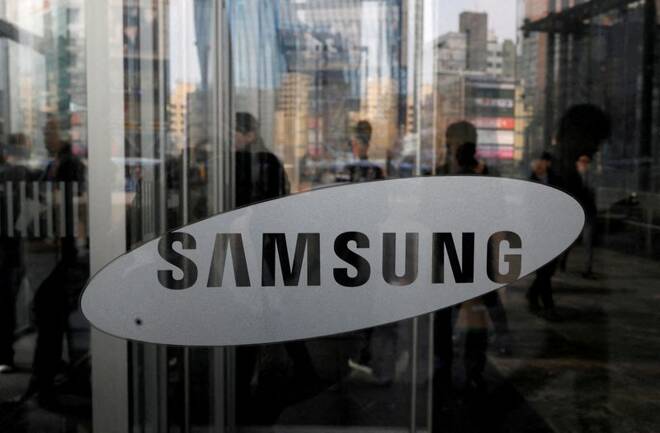Advertisement
Advertisement
Chips drive highest Samsung Q2 profit since 2018, but demand cooling
By:
SEOUL (Reuters) - Samsung Electronics Co Ltd reported a likely 11% jump in quarterly operating earnings on Thursday as lingering demand for its memory chips from server customers offset lower sales to inflation-hit smartphone makers.
By Joyce Lee and Heekyong Yang
SEOUL (Reuters) – South Korea’s Samsung Electronics Co Ltd turned in its best April-June profit since 2018 on Thursday, underpinned by strong sales of memory chips to server customers even as demand from inflation-hit smartphone makers cools.
Shares of the world’s largest memory-chip and smartphone maker closed up 3.2% after preliminary results were announced, versus a 1.8% rise in the wider market.
Shares of other chipmakers, including rival SK Hynix and the world’s biggest foundry TSMC, also rose as analysts said tight supply of certain chips could help offset slower demand that is driving down memory chip prices.
Samsung posted an operating profit of 14 trillion won ($10.7 billion), up 11% from 12.57 trillion won a year earlier, just shy of a 14.45 trillion won SmartEstimate from Refinitiv.
Revenue for the second quarter rose 21% to 77 trillion won, in line with market estimates.
The strong quarter for Samsung comes at a time when other chipmakers have warned of a looming chip glut at customers who stocked up during the pandemic to meet higher demand from people working from home.
Chipmakers including Micron and Advanced Micro Devices have also recently signalled waning demand as red-hot inflation squeezes spending.
“Memory chipmakers are expected to build inventory this year, keeping supply conservative, and hike shipments when prices rebound and demand recovers next year”, said Park Sung-soon, an analyst at Cape Investment & Securities.
Prices of specific DRAM chips, used in devices and servers, fell about 12% last month from a year ago, according to data provider TrendForce. Prices of NAND Flash chips, used for data storage, are also projected to fall as much as 5% in the July-September period from the previous quarter.

Smartphone demand weakens
Rising inflation, concerns about a downturn in major markets, the war in Ukraine and China’s COVID-19 lockdowns have resulted in slowing smartphone sales, leaving server chip demand as the only bright spot, analysts said.
Samsung’s profits have been shielded as large U.S. tech firms such as Amazon, Microsoft, Alphabet’s Google and Meta that use a lot of data centre services kept buying chips to meet cloud demand, they added.
Making a case for strong server demand, Taiwanese contract electronics supplier and Apple iPhone maker Foxconn on Monday raised its full-year outlook and said it was optimistic about the third quarter.
A strong dollar, which hit a 20-year high, may have also aided Samsung’s chip profits in the second quarter.
Samsung’s chip sales are made mainly in dollars, while it reports its profit in Korean won, so a firm greenback translates to higher chip earnings.
Estimated smartphone shipments by Samsung’s mobile business in the second quarter were about 62-64 million, about 5%-8% lower than a March estimate, Counterpoint Research said, as inflation hit smartphone demand.
Samsung shipped 74 million smartphones in the first quarter.
“This trend is the same for major global smartphone makers, although there is variance to some degree … In particular, the hit to the demand for low- and mid-end smartphones seems more severe,” said Jene Park, Senior analyst at Counterpoint.
($1 = 1,304.4400 won)
(Reporting by Joyce Lee and Heekyong Yang; Editing by Sayantani Ghosh and Himani Sarkar)
About the Author
Reuterscontributor
Reuters, the news and media division of Thomson Reuters, is the world’s largest international multimedia news provider reaching more than one billion people every day. Reuters provides trusted business, financial, national, and international news to professionals via Thomson Reuters desktops, the world's media organizations, and directly to consumers at Reuters.com and via Reuters TV. Learn more about Thomson Reuters products:
Latest news and analysis
Advertisement
